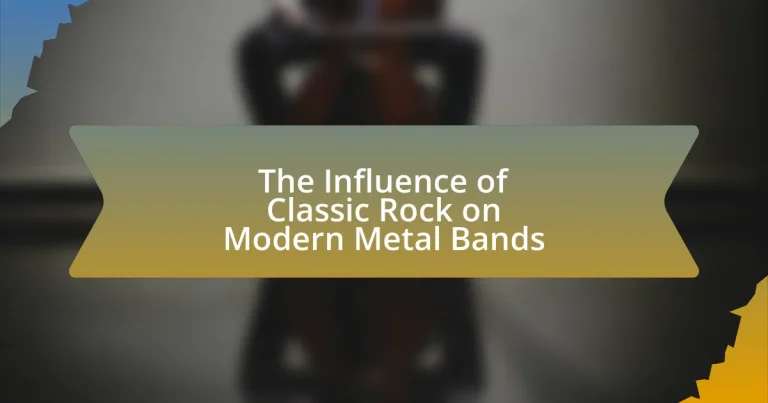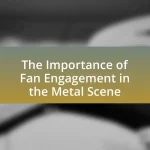The article examines the significant influence of classic rock on modern metal bands, highlighting how elements such as musical structure, lyrical themes, and performance styles have shaped contemporary metal music. It discusses the foundational contributions of iconic bands like Led Zeppelin and Black Sabbath, whose heavy guitar riffs and thematic depth laid the groundwork for modern metal’s sound. Key characteristics, including powerful guitar work and complex song structures, are explored, along with the cultural context that connects the two genres. The article also addresses how modern metal bands pay homage to classic rock through their music, lyrics, and visual aesthetics, illustrating the enduring legacy of classic rock in shaping the identity and sound of modern metal.
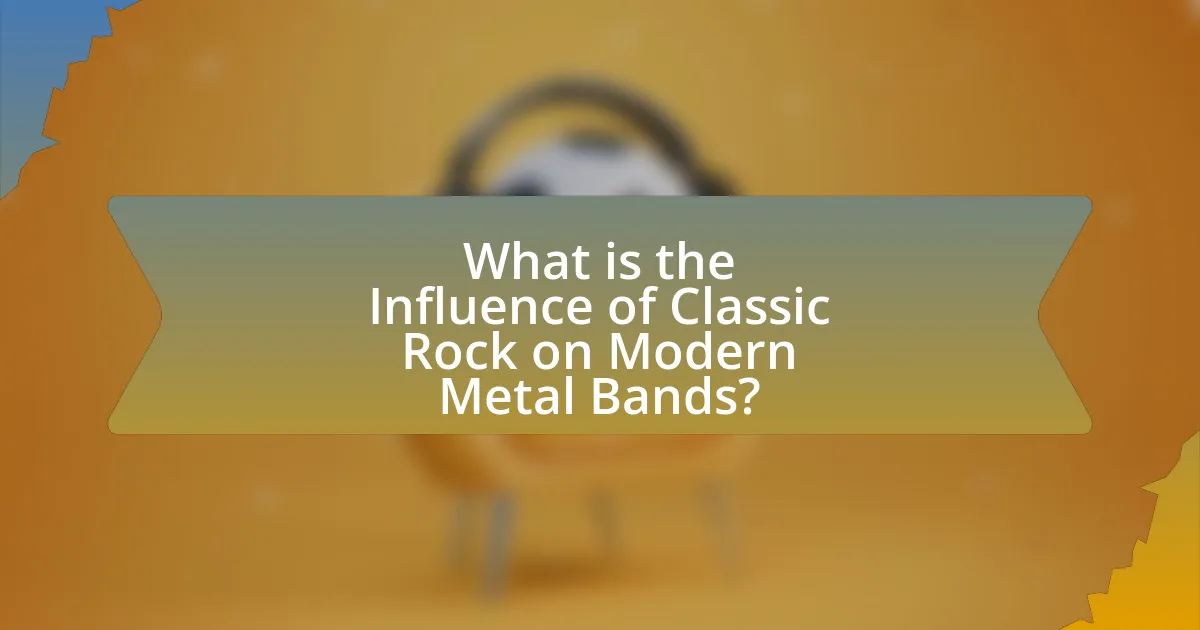
What is the Influence of Classic Rock on Modern Metal Bands?
Classic rock significantly influences modern metal bands through its musical structure, lyrical themes, and performance styles. Many modern metal bands adopt the complex guitar riffs and solos characteristic of classic rock, as seen in the works of Led Zeppelin and Deep Purple, which laid the groundwork for heavy metal guitar techniques. Additionally, the thematic exploration of rebellion, personal struggles, and social issues in classic rock resonates in the lyrics of contemporary metal bands, such as Metallica and Avenged Sevenfold. Furthermore, the theatrical stage presence and showmanship of classic rock artists have been emulated by modern metal performers, enhancing the overall concert experience. This lineage illustrates how classic rock not only shaped the sound but also the cultural and aesthetic elements of modern metal music.
How did Classic Rock shape the foundations of Modern Metal?
Classic Rock significantly shaped the foundations of Modern Metal through its innovative use of heavy guitar riffs, complex song structures, and powerful vocal styles. Bands like Led Zeppelin and Black Sabbath pioneered the heavy sound and thematic depth that would become hallmarks of Modern Metal. For instance, Black Sabbath’s self-titled debut album in 1970 introduced darker themes and heavier instrumentation, influencing countless metal bands that followed. Additionally, the technical proficiency and improvisational skills showcased by Classic Rock guitarists laid the groundwork for the virtuosic playing found in Modern Metal. The fusion of these elements established a framework that Modern Metal bands continue to build upon, creating a direct lineage from Classic Rock to the contemporary metal scene.
What key elements of Classic Rock are evident in Modern Metal?
Key elements of Classic Rock evident in Modern Metal include powerful guitar riffs, anthemic choruses, and a focus on musicianship. Modern Metal bands often draw inspiration from the iconic guitar solos and heavy distortion characteristic of Classic Rock, exemplified by artists like Led Zeppelin and Black Sabbath. Additionally, the use of dynamic song structures and lyrical themes that explore personal and social issues reflects the influence of Classic Rock’s storytelling approach. The technical proficiency displayed in both genres highlights a shared emphasis on instrumental skill, with Modern Metal musicians frequently showcasing complex rhythms and solos reminiscent of their Classic Rock predecessors.
How did the cultural context of Classic Rock influence Modern Metal?
The cultural context of Classic Rock significantly influenced Modern Metal by establishing foundational musical elements and themes that are prevalent in the genre. Classic Rock, characterized by its emphasis on guitar-driven sound, complex song structures, and lyrical themes of rebellion and personal struggle, laid the groundwork for Modern Metal’s aggressive instrumentation and thematic depth. Bands like Led Zeppelin and Black Sabbath pioneered heavy guitar riffs and darker lyrical content, which Modern Metal bands such as Metallica and Slipknot adopted and expanded upon. The cultural backdrop of the 1960s and 1970s, marked by social upheaval and a quest for identity, also resonated in Modern Metal’s exploration of existential themes and societal critique, reflecting a continuity of artistic expression from Classic Rock to Modern Metal.
Why is the connection between Classic Rock and Modern Metal significant?
The connection between Classic Rock and Modern Metal is significant because Classic Rock laid the foundational musical elements and stylistic innovations that Modern Metal builds upon. Classic Rock bands like Led Zeppelin and Black Sabbath pioneered heavy guitar riffs, complex song structures, and powerful vocals, which are essential characteristics of Modern Metal. For instance, Black Sabbath’s use of dark themes and heavy distortion directly influenced the development of genres such as doom metal and thrash metal. Additionally, the technical proficiency and showmanship exhibited by Classic Rock musicians set a standard for Modern Metal performers, fostering a culture of musicianship and theatricality that persists today. This lineage illustrates how Modern Metal not only pays homage to its Classic Rock predecessors but also evolves their musical legacy into contemporary forms.
What impact does this influence have on the sound of Modern Metal?
The influence of classic rock significantly shapes the sound of modern metal by incorporating melodic structures, guitar solos, and rhythmic patterns characteristic of classic rock. This integration results in a more diverse sonic palette, allowing modern metal bands to blend heavy riffs with melodic elements, enhancing their appeal. For instance, bands like Avenged Sevenfold and Alter Bridge draw heavily from classic rock influences, evident in their use of harmonized guitar solos and anthemic choruses, which are reminiscent of classic rock legends such as Led Zeppelin and Queen. This fusion not only broadens the genre’s musicality but also attracts a wider audience, bridging the gap between classic rock enthusiasts and modern metal fans.
How does this connection affect the identity of Modern Metal bands?
The connection to classic rock significantly shapes the identity of modern metal bands by infusing their music with foundational elements such as complex guitar solos, powerful vocals, and thematic depth. This influence is evident in the stylistic choices of bands like Avenged Sevenfold and Mastodon, who incorporate classic rock’s melodic structures and lyrical storytelling into their sound. For instance, Avenged Sevenfold’s album “City of Evil” showcases intricate guitar work reminiscent of 1970s rock, while Mastodon’s “Crack the Skye” reflects a narrative complexity akin to classic rock operas. These elements not only enhance the musicality of modern metal but also create a bridge between generations of rock music, allowing modern bands to establish a distinct identity that honors their predecessors while innovating within the genre.
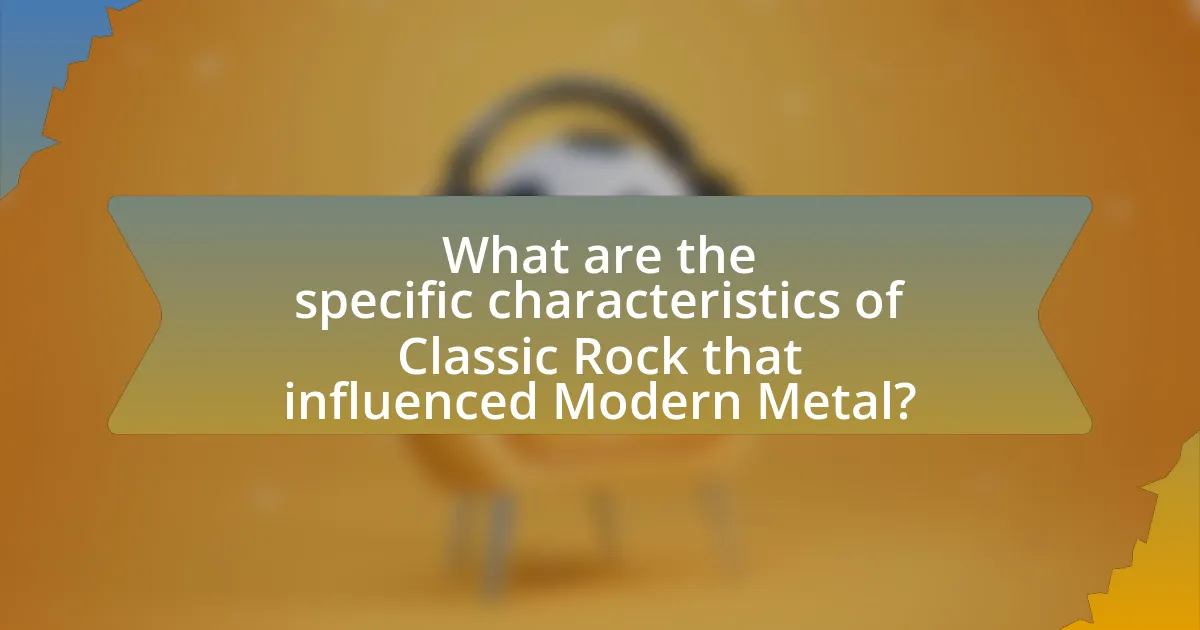
What are the specific characteristics of Classic Rock that influenced Modern Metal?
Classic Rock is characterized by powerful guitar riffs, strong melodies, and an emphasis on live performance, all of which significantly influenced Modern Metal. The use of distorted electric guitars and intricate solos in Classic Rock laid the groundwork for the heavier guitar work found in Modern Metal. Bands like Led Zeppelin and Deep Purple showcased complex song structures and dynamic shifts, which Modern Metal bands adopted to create more aggressive and technically proficient music. Additionally, the lyrical themes of rebellion and personal struggle prevalent in Classic Rock resonate in Modern Metal, reflecting a continuation of emotional expression. The rhythmic complexity and varied time signatures introduced by Classic Rock artists also paved the way for the progressive elements often found in Modern Metal compositions.
Which Classic Rock bands have had the most impact on Modern Metal?
Led Zeppelin, Black Sabbath, and Deep Purple are Classic Rock bands that have had the most significant impact on Modern Metal. Led Zeppelin’s heavy guitar riffs and dynamic song structures laid the groundwork for the sound of heavy metal. Black Sabbath is often credited with creating the genre itself, with their dark themes and heavy sound influencing countless metal bands. Deep Purple’s pioneering use of organ and guitar harmonies contributed to the development of hard rock and metal. These bands established musical elements such as power chords, complex solos, and thematic darkness that are foundational in Modern Metal.
What musical techniques did these bands introduce?
Classic rock bands introduced several musical techniques that significantly influenced modern metal bands, including the use of complex guitar solos, extended song structures, and the incorporation of diverse musical genres. For instance, bands like Led Zeppelin and Deep Purple utilized intricate guitar riffs and solos that became foundational in metal music, inspiring guitarists to explore technical proficiency and improvisation. Additionally, the use of dynamic shifts in tempo and volume, as seen in the works of Queen and Black Sabbath, allowed for greater emotional expression and complexity in songwriting, which modern metal bands have adopted to enhance their musical narratives. These techniques have been validated by the evolution of metal subgenres that emphasize technical skill and diverse influences, demonstrating the lasting impact of classic rock on contemporary music.
How did the lyrical themes of Classic Rock resonate with Modern Metal?
The lyrical themes of Classic Rock resonate with Modern Metal through shared motifs of rebellion, personal struggle, and existential reflection. Classic Rock often explored themes of defiance against societal norms, as seen in songs by bands like Led Zeppelin and The Rolling Stones, which laid the groundwork for Modern Metal’s focus on individualism and resistance. For instance, the angst and emotional depth found in the lyrics of Black Sabbath and Metallica reflect a continuation of the Classic Rock narrative, emphasizing inner turmoil and societal critique. This thematic continuity is evident in Modern Metal bands such as Slipknot and Avenged Sevenfold, which incorporate similar lyrical elements, showcasing a lineage that connects the two genres.
What role did guitar work in Classic Rock play in shaping Modern Metal?
Guitar work in Classic Rock significantly influenced the development of Modern Metal by establishing foundational techniques and stylistic elements. Classic Rock bands, such as Led Zeppelin and Black Sabbath, utilized powerful riffs, intricate solos, and heavy distortion, which became integral to the sound of Modern Metal. The use of techniques like palm muting and alternate picking, popularized by guitarists like Jimmy Page and Tony Iommi, directly informed the playing styles of Modern Metal guitarists. Additionally, the emphasis on technical proficiency and complex song structures in Classic Rock laid the groundwork for the progressive and technical aspects found in Modern Metal genres, such as progressive metal and metalcore.
How did guitar solos evolve from Classic Rock to Modern Metal?
Guitar solos evolved from Classic Rock to Modern Metal by transitioning from melodic and blues-influenced phrases to complex, technically demanding performances characterized by speed and precision. Classic Rock guitar solos, exemplified by artists like Jimi Hendrix and Eric Clapton, often emphasized emotional expression and improvisation, utilizing pentatonic scales and bluesy bends. In contrast, Modern Metal guitar solos, as seen in bands like Dream Theater and Metallica, incorporate advanced techniques such as sweep picking, tapping, and intricate harmonies, reflecting a shift towards technical proficiency and compositional complexity. This evolution is supported by the rise of guitar virtuosos in the 1980s, such as Yngwie Malmsteen and Steve Vai, who pushed the boundaries of guitar playing, influencing subsequent generations of metal musicians.
What techniques from Classic Rock guitarists are still used in Modern Metal?
Techniques from Classic Rock guitarists that are still used in Modern Metal include power chords, intricate solos, and the use of pentatonic scales. Power chords, popularized by bands like Led Zeppelin and AC/DC, provide a heavy, driving sound that is foundational in Modern Metal. Intricate solos, reminiscent of guitarists such as Jimi Hendrix and Eric Clapton, continue to influence the technical prowess displayed in Modern Metal guitar work. Additionally, the pentatonic scale, a staple in Classic Rock, remains prevalent in Modern Metal for crafting memorable riffs and solos, as seen in the works of bands like Metallica and Avenged Sevenfold. These techniques demonstrate a direct lineage from Classic Rock to the evolving sound of Modern Metal.
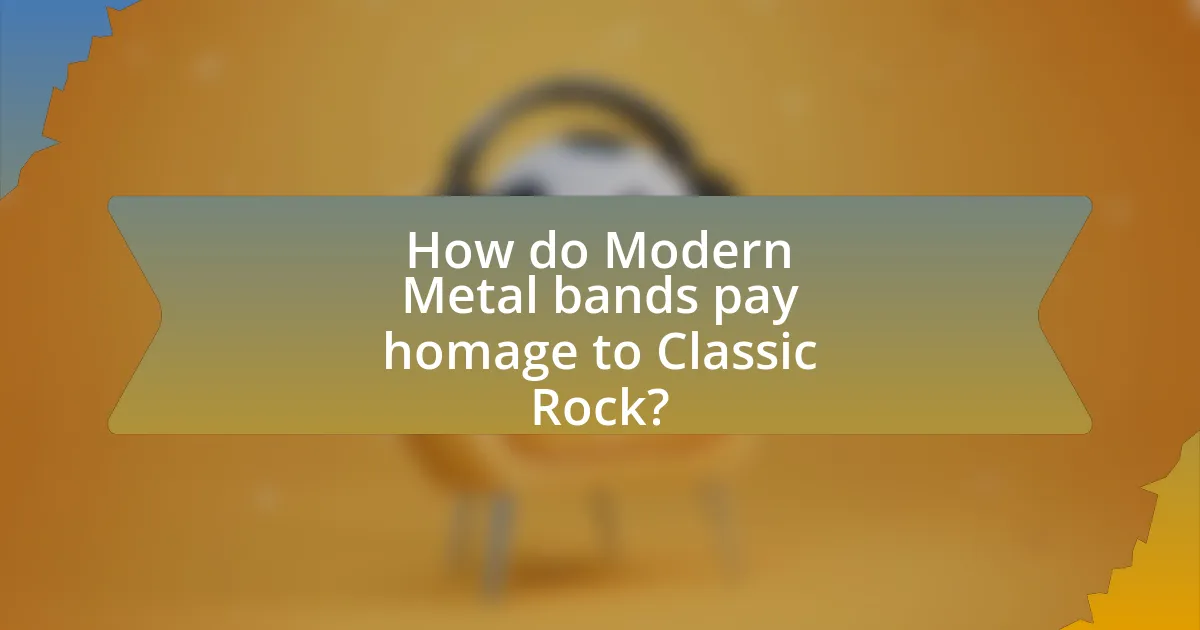
How do Modern Metal bands pay homage to Classic Rock?
Modern Metal bands pay homage to Classic Rock by incorporating similar musical structures, guitar solos, and lyrical themes. For instance, many Modern Metal bands utilize the classic verse-chorus format and emphasize powerful guitar riffs reminiscent of bands like Led Zeppelin and Black Sabbath. Additionally, the use of extended guitar solos, a hallmark of Classic Rock, is prevalent in the music of bands such as Trivium and Avenged Sevenfold, showcasing their respect for the technical prowess of earlier rock musicians. Furthermore, lyrical themes often reflect the storytelling and emotional depth found in Classic Rock, as seen in the works of bands like Mastodon, which draw inspiration from the narrative style of artists like Pink Floyd.
What are some examples of Modern Metal songs that reference Classic Rock?
Some examples of Modern Metal songs that reference Classic Rock include “The Way of the Fist” by Five Finger Death Punch, which incorporates elements reminiscent of Led Zeppelin’s “Immigrant Song,” and “Blackbird” by Alter Bridge, which pays homage to The Beatles’ “Blackbird.” Additionally, “The Sound of Silence” cover by Disturbed draws inspiration from the original by Simon & Garfunkel, showcasing a blend of modern metal with classic rock influences. These songs illustrate how contemporary metal artists integrate classic rock themes and styles into their music, reflecting the enduring impact of classic rock on the genre.
How do these references manifest in lyrics and instrumentation?
References to classic rock manifest in modern metal bands through lyrical themes and instrumental techniques. Lyrically, modern metal often incorporates storytelling elements and emotional depth reminiscent of classic rock, with topics ranging from personal struggles to societal issues, similar to the narratives found in songs by bands like Led Zeppelin and Pink Floyd. Instrumentally, modern metal bands frequently adopt guitar riffs, solos, and production styles that echo the sound of classic rock, utilizing techniques such as power chords and intricate solos that were popularized by artists like Jimi Hendrix and Black Sabbath. This blending of lyrical content and instrumentation creates a bridge between the two genres, showcasing the enduring influence of classic rock on the evolution of modern metal.
What are the common themes in these references?
The common themes in the references regarding the influence of classic rock on modern metal bands include musical innovation, lyrical depth, and cultural impact. Musical innovation is evident as modern metal bands often incorporate classic rock elements such as intricate guitar solos and diverse song structures, which can be traced back to iconic classic rock artists like Led Zeppelin and Deep Purple. Lyrical depth is another theme, as many modern metal bands draw inspiration from the storytelling and emotional resonance found in classic rock lyrics, reflecting personal and societal issues. Lastly, the cultural impact theme highlights how classic rock has shaped the identity and sound of modern metal, with bands like Metallica and Avenged Sevenfold acknowledging their roots in classic rock influences, thus bridging generational gaps in music.
How do Modern Metal bands incorporate Classic Rock aesthetics?
Modern Metal bands incorporate Classic Rock aesthetics through the use of melodic structures, guitar solos, and lyrical themes reminiscent of the classic era. For instance, many Modern Metal bands adopt the extended guitar solos and harmonies that were hallmarks of Classic Rock, as seen in the works of bands like Avenged Sevenfold, which often features intricate solos similar to those of Led Zeppelin and Queen. Additionally, the lyrical content frequently explores themes of rebellion, love, and existentialism, paralleling the storytelling found in Classic Rock songs. This blending of styles not only pays homage to the past but also enriches the Modern Metal genre, creating a bridge between generations of rock music.
What visual elements from Classic Rock are present in Modern Metal performances?
Modern Metal performances incorporate several visual elements from Classic Rock, including elaborate stage setups, dramatic lighting, and iconic fashion choices. Classic Rock bands often utilized large backdrops, intricate lighting designs, and theatrical performances to enhance their shows, which have been adopted by Modern Metal acts to create an immersive experience. For instance, the use of pyrotechnics and visual effects in concerts can be traced back to Classic Rock legends like KISS and Led Zeppelin, who set a precedent for high-energy visual spectacles. Additionally, the leather jackets, band t-shirts, and distinctive hairstyles seen in Classic Rock are frequently emulated by Modern Metal musicians, reinforcing a visual continuity between the genres.
How does the fashion of Modern Metal reflect Classic Rock influences?
The fashion of Modern Metal reflects Classic Rock influences through the incorporation of leather jackets, band t-shirts, and heavy metal accessories. These elements are reminiscent of the iconic styles worn by Classic Rock bands in the 1960s and 1970s, such as Led Zeppelin and The Rolling Stones, who popularized a rebellious aesthetic. Additionally, the use of dark colors and dramatic hairstyles in Modern Metal echoes the flamboyant and edgy looks of Classic Rock artists, reinforcing a connection to the genre’s roots. This continuity in fashion highlights the enduring impact of Classic Rock on the identity and visual representation of Modern Metal bands.
What can Modern Metal bands learn from Classic Rock?
Modern Metal bands can learn the importance of melody and song structure from Classic Rock. Classic Rock often emphasizes strong hooks and memorable choruses, which can enhance the accessibility of Modern Metal music. For instance, bands like Led Zeppelin and Queen utilized intricate arrangements and dynamic shifts, which can inspire Modern Metal musicians to incorporate more varied musical elements and emotional depth into their compositions. This approach not only broadens their audience appeal but also enriches the overall listening experience, as evidenced by the enduring popularity of Classic Rock tracks that continue to resonate with listeners today.
How can Modern Metal bands effectively blend Classic Rock elements into their music?
Modern Metal bands can effectively blend Classic Rock elements into their music by incorporating traditional song structures, guitar solos, and melodic hooks characteristic of Classic Rock. This approach allows them to create a familiar yet contemporary sound that resonates with a broader audience. For instance, bands like Avenged Sevenfold and Alter Bridge utilize extended guitar solos and anthemic choruses, reminiscent of Classic Rock legends such as Led Zeppelin and Queen. Additionally, the use of vintage amplifiers and recording techniques can enhance the authenticity of the sound, further bridging the gap between the two genres.
What best practices can be adopted from Classic Rock to enhance Modern Metal’s appeal?
To enhance Modern Metal’s appeal, incorporating strong melodic structures and guitar solos from Classic Rock is essential. Classic Rock bands like Led Zeppelin and Queen utilized intricate melodies and extended guitar solos, which created memorable hooks and emotional depth in their music. This approach can attract a broader audience by emphasizing musicality alongside heavy instrumentation. Additionally, adopting the storytelling aspect prevalent in Classic Rock lyrics can provide depth and relatability, as seen in songs by artists like Bob Dylan and The Rolling Stones, which often explore personal and societal themes. By integrating these elements, Modern Metal can resonate more with listeners seeking both intensity and musical sophistication.
